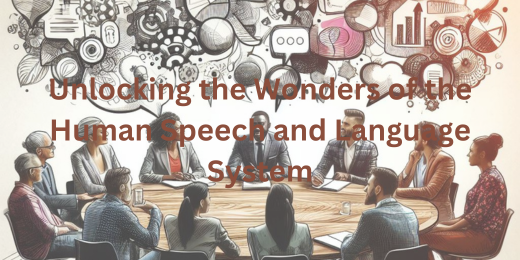The Human Speech and Language System is the extraordinary mechanism that enables us to communicate, connecting individuals and shaping societies. Its importance lies in its ability to convey thoughts, emotions, and knowledge, making it the cornerstone of human interaction. This intricate system comprises several components working seamlessly.
Firstly, there’s the process of speech production, involving the vocal cords, tongue, lips, and more, which allows us to articulate sounds. Equally crucial is language processing, where our brains decipher and construct meaning from spoken or written words. Additionally, there’s the expressive aspect, enabling us to convey our thoughts and feelings effectively.
Understanding the significance and inner workings of this system is vital, as it not only defines our humanity but also influences our personal and professional lives. Delving deeper into these components, we can unlock the marvels of the Human Speech and Language System, appreciating the beauty and complexity of our ability to communicate.
The Vocal Tract
The vocal tract, a marvel of human anatomy, is the instrument responsible for producing the rich tapestry of sounds that constitute human speech. Understanding its intricacies is key to comprehending the Human Speech and Language System.
The vocal tract comprises various components, including the lungs, vocal cords, tongue, lips, and more, each playing a unique role in the production of speech sounds. As air from the lungs is expelled, it passes through the vocal cords, where they vibrate to create sound. The tongue, teeth, and lips further modify these sounds, giving rise to the diversity of speech sounds.
These sounds can be broadly categorized into vowels and consonants, with each category encompassing distinct speech sounds. Vowels are produced with a relatively open vocal tract, while consonants involve constriction or closure at various points.
Exploring the vocal tract’s anatomy and its role in creating speech sounds allows us to appreciate the incredible complexity and precision behind our ability to communicate through spoken language.
The Speech Motor System
The Human Speech and Language System is a complex orchestra of muscles and coordination, where the speech motor system takes the center stage. This system involves a network of muscles that orchestrate the movements necessary for speech production.
Key players in this symphony include the tongue, lips, jaw, and the muscles around the vocal cords. These muscles work in harmony, contracting and relaxing with precision to create the sounds needed for speech. When we speak, the brain sends signals to these muscles, directing them to move in specific ways to articulate words and sounds accurately.
However, like any orchestra, disruptions can occur. Speech can be impaired through various means, such as neurological conditions, muscle weakness, or injuries. These issues can affect the smooth coordination of the speech motor system, leading to difficulties in articulation and fluency.
Understanding the intricate dance of muscles in the speech motor system sheds light on the incredible complexity of the Human Speech and Language System, highlighting the marvel of our ability to communicate through spoken words. The lymphatic system, on the other hand, works to filter and transport lymph, and helps with immune defense, fluid balance, and removal of waste from tissues.
The Speech Perception System
Within the intricate framework of the Human Speech and Language System, the speech perception system acts as the brain’s interpreter, deciphering the rich tapestry of speech sounds into meaningful communication. This process involves remarkable intricacies.
When we hear speech, our brain rapidly processes the sounds, distinguishing between different phonemes and identifying patterns that form words. This decoding happens swiftly, allowing us to grasp the meaning behind spoken words effortlessly.
However, just as a translator may encounter obstacles, speech perception can also face challenges. Hearing impairments, neurological conditions, or developmental issues can hinder this process, making it harder to understand speech accurately.
Understanding the role of the speech perception system unveils the magic of our ability to comprehend spoken language. It’s a testament to the intricate workings of the Human Speech and Language System, highlighting the brain’s remarkable capacity to transform sound into meaning. Similarly, the renal system is vital in maintaining fluid balance, filtering waste, and regulating blood pressure. It plays a crucial role in overall health and homeostasis.
The Language Processing System
At the heart of the Human Speech and Language System lies the language processing system, a remarkable cognitive mechanism that empowers us to generate and comprehend language. This intricate system involves two vital processes: language production and language comprehension.
Language production allows us to formulate thoughts into coherent sentences. Our brains assemble words, grammar, and syntax to convey ideas effectively. Meanwhile, language comprehension is the brain’s ability to decipher spoken or written words, extracting meaning from them.
These processes usually occur seamlessly, but they can face challenges. Language processing impairments can stem from various factors, including neurological conditions, developmental disorders, or brain injuries. Such impediments may hinder our ability to express thoughts or comprehend language accurately.
Understanding the intricacies of the language processing system unveils the extraordinary depth of the Human Speech and Language System. It showcases the brain’s unparalleled capacity to craft and decode the linguistic tapestry that defines human communication.
Conclusion
As we delve deeper into unraveling the mysteries of the Human Speech and Language System, the future of speech and language research holds exciting possibilities. Advances in neuroscience, linguistics, and technology promise to shed even more light on how our brains process and produce language.
This knowledge not only enriches our understanding of human communication but also opens doors to innovative therapies for individuals with speech and language impairments, offering them brighter prospects for effective communication.
For those eager to explore further, numerous resources, academic institutions, and research organizations dedicate themselves to the study of the speech and language system. Delving into these sources can provide a wealth of information, from the latest breakthroughs to practical insights for speech and language professionals.
As we journey ahead, our understanding of the Human Speech and Language System will continue to evolve, enhancing our appreciation of this extraordinary aspect of human existence.



